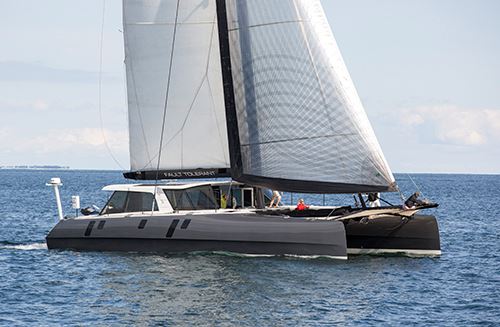Moldmaker bypasses patterns for high-tech production catamarans
Direct-to-milled-tool process simplifies large deck mold development.
Cruising catamaran builder Gunboat International (Wanchese, NC, US) is well known for its high-performance, ocean-going vessels, ranging in length from 17 to 27m, that make use of raceboat technology while delivering comfortable customer amenities. The company’s all-carbon-fiber sandwich design, and a production strategy that infuses hulls and connecting bridge as one part — no joints — greatly reduces hull weight while delivering high stiffness.
Gunboat’s designs require complex, multi-part tools, which are provided by tooling specialist mouldCAM (Bristol, RI, US). “We are going ‘direct to milled tool’ and avoiding the step of building patterns,” says Gunboat founder Peter Johnstone. Jason Cilio, mouldCAM’s program manager, explains the process: “We start with the three-dimensional CAD surfaces, and produce a CNC cutting file.”
For the large mold used to produce a one-piece deck for the Gunboat 78 catamaran (pictured at left), mouldCAM’s 5-axis CNC milling machine, supplied by CMS North America Inc.(Caledonia, MI, US) is used to rough-cut the approximate mold shape from expanded polystyrene (EPS) foam blocks, to create a geometry that is slightly smaller in profile than the final part. Then, a single ply of fiberglass/epoxy laminate is applied to the machined EPS. The double-bias (±45°) fiberglass is often supplied by SAERTEX USA LLC (Huntersville, NC, US), and is wet out with epoxy resins from either Pro-Set Inc. (Bay City, MI, US) or Axson US Inc. (Madison Heights, MI, US), depending on the engineering requirements.
Then, explains Cilio, a worker applies seamless epoxy modeling paste, supplied by Axson, over the cured laminate, at a thickness of ~15 mm. The paste is applied in overlapping ribbons and cures at room temperature. The resulting shape is slightly larger than the finished mold, and is then “finish-machined” to achieve final part shape, with <1 mm tolerance.
A Duratec mold coating from Hawkeye Industries Inc. (Bloomington, CA, US) is applied to the final machined surface, which is supported by a steel/plywood frame to ensure its stiffness. The 78 deck mold was built in four sections, each built separately, to allow for shipment by truck to Gunboat. The mold surfaces have registration features and flanges that enable assembly at the Gunboat facility prior to deck production, says Cilio.
“We offer a robust direct-to-mold process that provides dimensionally accurate parts, for a relatively low cost investment,” asserts Cilio. The process eliminates the need for an intermediate splash or pattern, which saves considerable time and labor.
Cilio does caution that the EPS foam must be handled with care to avoid exposure to excessive heat, and mold releases must be carefully selected to avoid the risk of damage during part demolding.
SikaAxson US
Related Content
-
KU researchers explore FRP materials for dams, levee reinforcement
To address aging infrastructure, a team of researchers at KU is conducting research into repairing and retrofitting 700-plus dams, levees and related structures nationwide using FRP materials.
-
Composites reinvent infrastructure
Celebrating National Composites Week, CW shares ways in which composites continue to evolve the way we approach infrastructure projects.
-
CirculinQ: Glass fiber, recycled plastic turn paving into climate solutions
Durable, modular paving system from recycled composite filters, collects, infiltrates stormwater to reduce flooding and recharge local aquifers.




















